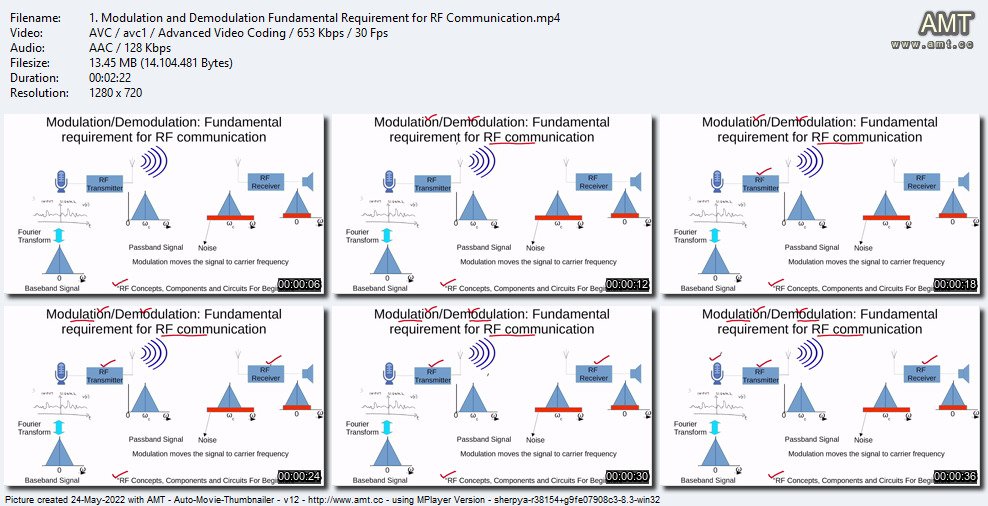
Published 05/2022
MP4 | Video: h264, 1280×720 | Audio: AAC, 44.1 KHz, 2 Ch
Genre: eLearning | Language: English + srt | Duration: 92 lectures (4h 47m) | Size: 1.63 GB
RF Transceiver Design Methods: Direct Conversion, Hetrodyne, Dual Conversion, Sliding IF, Image Reject, Zero IF & Low IF
What you’ll learn
Radio Frequency (RF) Transceiver architectures
Direct Conversion Transmitter and Receivers
Superheterodyne Receivers and Transmitters
Dual Conversion IF Receivers,
Sliding IF Receivers
Image Reject Receivers (Hartley and Weaver Architectures)
Zero Second IF Receivers
Low IF Receiver
Requirements
Complete Understanding of RF fundamentals
Description
RF Signals are widely used in wireless communication, automation and the rapidly emerging phenomenon of Internet of Things (Iot) making RF technology essential in any device. This course describes and discusses key performance aspects of RF and wireless transceiver architectures. In this course you will learn about these types of RF transceiver architectures
Direct Conversion Transmitter and Receivers
Hetrodyne Transmitter And Receivers
Dual Conversion IF Receiver
Sliding IF Receivers
Zero Second IF Receiver
Image Reject Receivers (Hartley & Weaver)
Low IF Receivers
We will also study from the design perspective what are the drawbacks and the advantages of different architectures in a comparative manner, highlighting the design choices in different scenarios.
This online RF and microwave course is ideal for new entrants to the field of RF and microwave engineering. Students and job seekers will also find the course beneficial since it covers areas likely to arise during a technical interview. Technical sales engineers and technical managers who need to improve their understanding of RF and microwave communications in order to better manage projects. The contents of this course are
Section 1: Introduction
Modulation and Demodulation: Fundamental Requirement for RF Communication
Amplitude Modulation in Time and Frequency Domain
Amplitude Demodulation in Time and Frequency Domain
The Bigger Picture: Transmitter Block Diagram
The Bigger Picture-Receiver Block Diagram
Quadrature Amplitude Modulation and Demodulation
Quadrature Phase Shift Keying (QPSK) Modulation
Quadrature Phase Shift Keying (QPSK) Demodulation
Difference Between Frequency Band and Channel
General Considerations for Narrow channel Bandwidth on Transmitter Side
Considerations for Narrowband Receiver Side: Channel Selection Vs Band Selection
Section 2: RF Receiver Architectures
Direct Conversion Receivers
Drawbacks of Direct Conversion Receivers-Local Oscillator Leakage
Local Oscillator Leakage Cancellation Technique
Drawback of Direct Conversion Receivers: DC Offsets
Cancellation of DC Offsets Using AC Coupling
Draw Back Of Direct Conversion Receiver: Sensitivity to Even-Order Distortion
Lecture 18:Solution to Even-Order Distortion
Drawbacks of Direct Conversion Receiver: Effect of Flicker Noise
I/Q Mismatch in Direct Conversion Receivers
Analysis of I/Q Mismatch
Analysis I/Q Mismatch with Gain Error
Effect of I/Q Mismatch In presence of Phase Error
Computation and Correction I/Q Mismatch
Hetrodyne Receiver Architecture
How A Heterodyne Receiver Receives Different Channels In a Given Frequency Band?
Advantages of Hetrodyne Receiver Over Direct Conversion Receiver
Problem of Image Frequency in Hetrodyne Receivers
An Example of Image
High Side and Low Side Injection
Image Frequency Example 1
Image Frequency Example 2
Image Reject Filter
Image Rejection Vs Channel Selection Trade-off in Hetrodyne Receivers
Is Image Reject Filter Required In Absence Of Interferers?
Dual Conversion IF Receiver
Dual Conversion Receiver Noise Figure And Linearity Considerations
Problems of Mixing Spurs in Dual Conversion Receivers
Example Showing Effect Of Mixing Spurs
Advantages and Disadvantages Of Dual Conversion IF Receivers
Modern Hetrodyne Receivers
Secondary Image Problem in Modern Dual Conversion Receivers
Zero Second IF Receivers
Demodulation of Symmetric Vs Asymmetric Signals in Zero 2nd IF Receivers
Zero 2nd IF Receiver With Quadrature Downconversion for Asymmetric Signals
Advantages of Zero Second IF Receivers
Sliding IF Receivers
Sliding IF Receivers: Divide by 2 Circuit
Sliding IF Receivers: Divide by 4 Circuit
Comparison of Divide by 2 and Divide by 4 Sliding IF Receivers
Example: Sliding IF Receiver type for 802.11g
Dual Band Zero Second IF Receiver
Image Reject Receivers
Phase Shift in Cosine Signal
90 Degree Phase Shift in Modulated Signal
How to Implement 90 degree Phase Shift: RC-CR Network?
90 degree Phase Shift using Quadrature Downconversion with High Side Injection
90 degree Phase Shift using Quadrature Downconversion with Low Side Injection
Hartley Image Reject Receiver Architecture
Realization of 90 Degree Phase Shift in Hartley Architecture
Disadvantages of Hartley Image Reject Receiver
Weaver Image Reject Receiver Architecture
Secondary image problem in Weaver Architecture and Its Solution
Low IF Receiver Architectures
Image Rejection in Low IF Receivers
Section 3:RF Transmitter Architectures
Characteristics of an RF Transmitter
Direct Conversion Transmitters
I/Q Mismatch in QPSK Direct Conversion Modulator
I/Q Mismatch Quantification
I/Q Mismatch Calibration-Phase Mismatch Removal
I/Q Mismatch Calibration-Gain Mismatch Removal
Effect Of Carrier Leakage in Direct Conversion Transmitters
Reduction Of Carrier Leakage
Effect of Mixer Non-Linearity in Direct Conversion Transmitters
Effect of Non-Linearity in Power Amplifier and its Solution
Problem Of Oscillator Pulling in Direct Conversion Transmitters and its Solution
Solutions to Oscillator Pulling using Frequency Divider and Frequency Doubler
Solution to Oscillator Pulling Using Mixing
Single SideBand (SSB) Mixing To Solve Oscillator Pulling
Corruption From Harmonics in Single SideBand (SSB) Mixing
SSB Mixing To Generate Quadrature Output
Direct Conversion Tx Using SSB Mixing
Hetrodyne Transmitters
Sliding IF Hetrodyne IF Transmitter
Carrier Leakage In Hetrodyne Transmitters
Problem of Mixing Spurs in Hetrodyne Tx Due To Local Oscillator Harmonics
Use of SSB Mixing to Suppress the Unwanted Sidebands in Hetrodyne Transmitters
On-off Keying (OOK) Transmitter and Receiver
Section 4:RF Transceiver Architectures
What is an RF Transceiver?
Time Division Duplexing (TDD) Transceiver
Frequency Division Duplexing (FDD) Transceiver
Tx-Rx Leakage in FDD Transceiver
Who this course is for
Wireless Design Engineers
RF Design Engineers
Radio Frequency enthusiasts
Electrical & Electronic Engineers
Microwave Technicians and Engineers

Password/解压密码www.tbtos.com
转载请注明:0daytown » Transmitter & Receiver Design Architectures for RF Systems